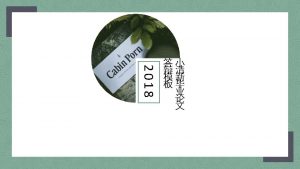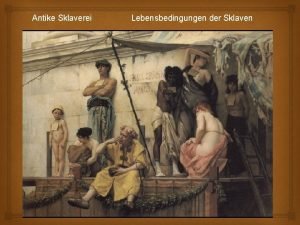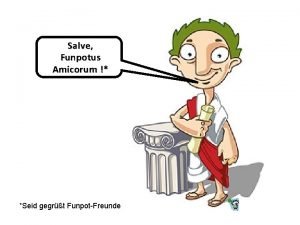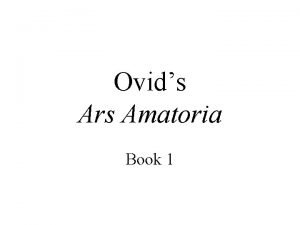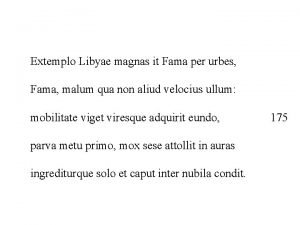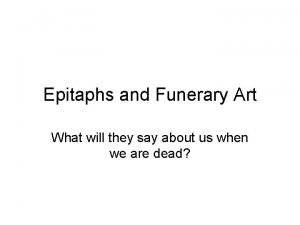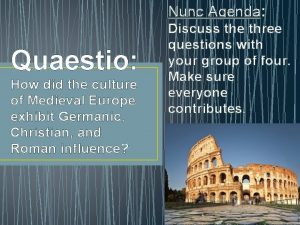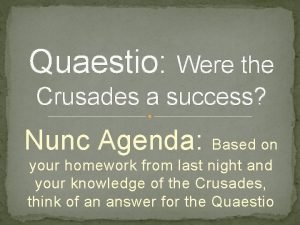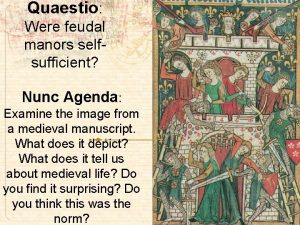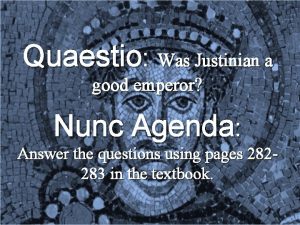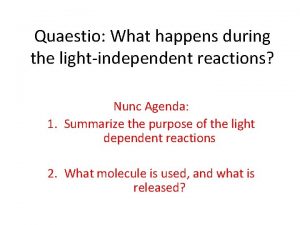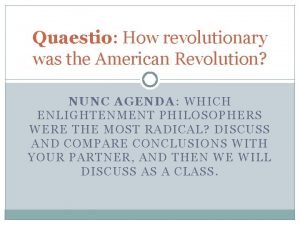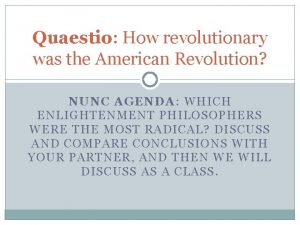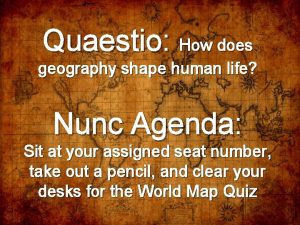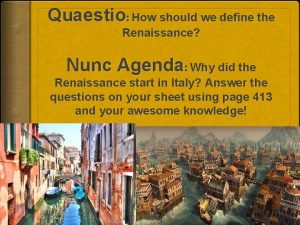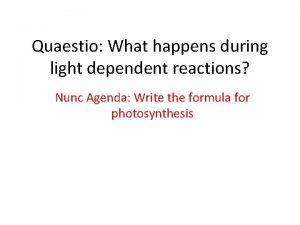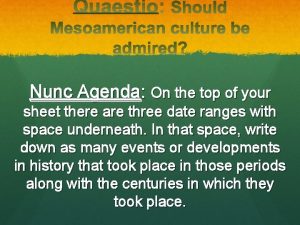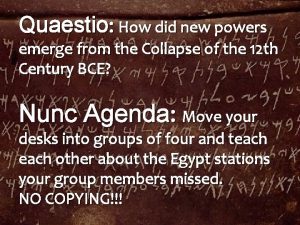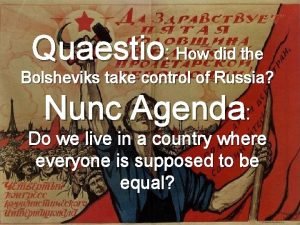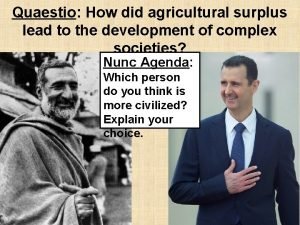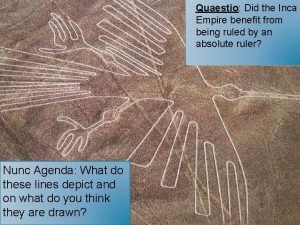Nunc Agenda Quaestio How did the culture of




















- Slides: 20

Nunc Agenda: Quaestio: How did the culture of Medieval Europe exhibit German, Christian, and Roman influence? Discuss the three questions with your group of four. Make sure everyone contributes.

Fall of Rome – Germanic Perspective • What happened to Western Europe after the decline of the Roman Empire? • Do you think the Germanic peoples would have viewed decline of the Roman Empire as a positive or a negative change? Why or why not? • Without an emperor in Western Europe, which individual do you think had the highest authority in the region? Explain your reasoning.


Middle Ages • Period from about 500 -1500 CE, between the decline of Rome and the beginning of the Renaissance, or “Rebirth” of Europe (Medieval means “Middle Age”) • 500 -1000 CE sometimes called the Dark Ages because, while the China, the Middle East, the Byzantine Empire, and India were advancing, Western Europe was in decline • Mostly rural, feudal lifestyle • Minimal long-distance trade

Middle Ages • Western Church (aka Catholic Church) = main power in Western Europe, unifying force • Blending of Roman, Christian, and Germanic culture

Germanic Lands • Germanic tribes that conquered Roman lands created their own kingdoms • Germanic tribes originally pagans (polytheistic), but began to adopt Christianity, although most were Arian Christians, considered heresy by the Catholic Church

Rise of the FRANKS! • 486 - Clovis, King of the Franks, Conquered Gaul (which later became France) • Converted to Catholic Christianity, became allied with Pope, used religion as an excuse to kill and conquer pagan and heretical tribes • Put conquered people in army to make them loyal to him • Murdered all extended family so no one could challenge him for


The Battle of Tours • 700 s: Muslims expanded into North Africa, Spain, and then France • Charles “Martel” (“The Hammer”) was a Frankish military leader who had power over the King • Charles Martel united Franks and creates a trained and disciplined army, unlike typical Germanic “barbarian hordes” which surprised the Muslims • 732 - The Battle of Tours: Franks defeated the invading Muslims and drove them back to Spain



The Battle of Tours • Charles Martel seen as a hero to the Franks and a savior of Christianity in Europe • His heirs became the Carolingian Kings, and his grandson Charlemagne was the most famous



Charlemagne – Different Perspectives • First, read and record the assigned task for your group. • Then, read together and annotate the reading on Charlemagne to prepare for writing • Finally, work as a group to write your own editorial article. You should include a picture with a caption, and you can write the article in columns. Make sure to include as many examples as possible from the reading. •

Different Perspectives • Carolingian Chronicle • Frankish perspective. Fully supportive of Charlemagne in every way. Celebrates his greatness in military victory, political leadership, and educational reform. • Heathen Herald • Pagan Saxon perspective. Supportive of traditional Germanic culture, especially pre-Christian Germanic paganism. Opposed to the Christianization of the Germanic peoples and extremely angered by Charlemagne's treatment of the Saxons. Keep in mind, however, that many Saxons have converted

Different Perspectives • Byzantine Bugle • Byzantine perspective. Supportive of the authority of the Byzantine Emperor in Constantinople, seen as the true emperor of the Romans. You view Charlemagne as undeserving of the title of Emperor, and view the Pope as far exceeding the limits of his power by declaring him Emperor. • Papal Press • Roman Catholic perspective. Supportive of the pope as the supreme authority over all Christendom (Christian World) above all religious and secular (non-religious) leaders. Supportive of Charlemagne as defender of Catholic Church and of the Pope. Agrees with choice of Charlemagne as Emperor.

Charlemagne Summary…

Great? • • Charlemagne = Charles the Great Grandson of Charles Martel Becomes King of Franks in 768 Built empire across France Germany Italy Poland Switzerland • 799 - helped Pope Leo III defeat his opponents in Rome • Christmas 800 - Pope crowned him “Emperor of Rome” • So… Christian Pope declares Germanic King the Roman Emperor… and Christendom (Christian

Charlemagne – Great? • Spread Christianity as he conquered (Convert or Die) • Any secret pagans caught were executed • Let nobles rule local regions, but also sent officials to keep an eye on nobles, check on the people • Carolingian Renaissance • Tried to bring back Latin education and create schools • Learned to read himself • Seen as a light in a dark age • Had five wives, five concubines, and 20 kids!
 Agenda sistemica y agenda institucional
Agenda sistemica y agenda institucional Nunc viverra imperdiet enim. fusce est. vivamus a tellus.
Nunc viverra imperdiet enim. fusce est. vivamus a tellus. Ad nunc
Ad nunc Lavabatur in villa formiana
Lavabatur in villa formiana Penis lumumba
Penis lumumba Nec
Nec Extemplo libyae magnas it fama
Extemplo libyae magnas it fama Viator viator quod tu es ego fui quod nunc sum et tu eris
Viator viator quod tu es ego fui quod nunc sum et tu eris Material culture examples
Material culture examples Sociologists define a symbol as
Sociologists define a symbol as Batch culture vs continuous culture
Batch culture vs continuous culture Continuous culture and batch culture
Continuous culture and batch culture Collectivistic cultures
Collectivistic cultures American vs indian culture
American vs indian culture Stab and stroke culture
Stab and stroke culture Folk culture and popular culture venn diagram
Folk culture and popular culture venn diagram Subculture group
Subculture group How does popular culture diffuse
How does popular culture diffuse Urease test
Urease test Folk culture and popular culture venn diagram
Folk culture and popular culture venn diagram Adaptive culture from inert culture
Adaptive culture from inert culture

